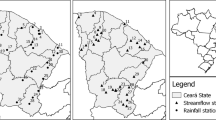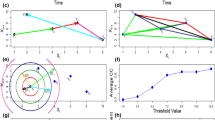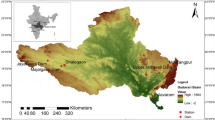Abstract
Adequate knowledge of the complexity of streamflows in river basins is important for proper assessment, planning, and management of our water resources. However, identification of the complexity of streamflows is very challenging, due to the various mechanisms governing the streamflow process both in space and in time. The present study examines the complexity of daily streamflows in the west-flowing rivers of India. The false nearest neighbor (FNN) algorithm, a nonlinear dynamic-based method, is employed to determine the dimensionality of streamflow time series and, hence, to examine the complexity. The FNN method uses reconstruction of the single-variable streamflow time series in a multi-dimensional phase space, and identifies the FNNs in the reconstructed phase space. Daily streamflow time series from 13 gaging stations in the Tapi to Tadri basin are analyzed. The effect of delay time on the FNN dimension estimation of the 13 streamflow series is also investigated, by considering four different delay time values to represent different kinds of separation of elements in the phase space reconstruction vector (daily, annual, autocorrelation, mutual information). Collectively considering the different delay time values, the FNN dimensions for the 13 streamflow series are found to have a wide range of variability (with dimensions ranging from 5 to 20), indicating a wide range of complexity in the dynamics of streamflow in the Tapi to Tadri basin. The results generally reveal that: (1) for any given station, the FNN dimensions change with changes in delay time; and (2) for any given delay time, the FNN dimensions change for the different stations. There does not seem to be any clear pattern in the spatial variability of streamflow across the entire basin, although there are small pockets of local similarity. Based on the FNN dimension results, potential issues in the application of the FNN method to the streamflow series in the Tapi to Tadri basin (and streamflow, more broadly) are also discussed. The outcomes of the present study have important implications for streamflow data monitoring, streamflow modeling and forecasting, flood frequency analysis, environmental flow requirements, and water resource assessment, among others.






Similar content being viewed by others
References
Aittokallio T, Gyllenberg M, Hietarinta J, Kuusela T, Multamäki T (1999) Improving the false nearest neighbors method with graphical analysis. Phys Rev E 60(416–421):782
Anand J, Gosain AK, Khosa R, Srinivasan R (2018) Regional scale hydrologic modeling for prediction of water balance, analysis of trends in streamflow and variations in streamflow: the case study of the Ganga River basin. J Hydrol Reg Stud 16:32–53
Asokan SM, Dutta D (2008) Analysis of water resources in the Mahanadi River basin, India under projected climate conditions. Hydrol Process 22:3589–3603
Cao L (1997) Practical method for determining the minimum embedding dimension of a scalar time series. Physica D 110:43–50
Carrión IM, Antúnez EA, Castillo MMA, Canals JJM (2010) Parallel implementations of the false nearest neighbors method to study the behavior of dynamical models. Math Comput Model 52:1237–1242
Carrión IM, Antúnez EA, Castillo MMA, Canals JJM (2011) A prediction method for nonlinear time series analysis by combining the false nearest neighbors and subspace identification methods. Int J Appl Math Inform 5:258–265
Central Water Commission (2014) West flowing rivers from Tapi to Tadri. Ministry of Water Resources, Government of India, New Delhi
Dhanya CT, Nagesh Kumar D (2011) Predictive uncertainty of chaotic daily streamflow using ensemble wavelet networks approach. Water Resour Res 47:W06507
Dhanya CT, Nagesh Kumar D (2013) Predictability and chaotic nature of daily streamflow. Aust J Wat Resour 17(1):1–12
Fraser AM, Swinney HL (1986) Independent coordinates for strange attractors from mutual information. Phys Rev A 33(2):1134–1140
Grassberger P, Procaccia I (1983) Measuring the strangeness of strange attractors. Physica D 9:189–208
Grayson RB, Blöschl G (2000) Spatial patterns in catchment hydrology: observations and modeling. Cambridge University Press, Cambridge
Heald JPM, Stark J (2000) Estimation of noise levels for models of chaotic dynamical systems. Phys Rev Lett 84(11):2366–2369
Hegger R, Kantz H (1999) Improved false nearest neighbor method to detect determinism in time series data. Phys Rev E 60(4):4970–4973
Holzfuss J, Mayer-Kress G (1986) An approach to error-estimation in the application of dimension algorithms. In: Mayer-Kress G (ed) Dimensions and entropies in chaotic systems. Springer, New York, pp 114–122
Islam MN, Sivakumar B (2002) Characterization and prediction of runoff dynamics: a nonlinear dynamical view. Adv Water Resour 25:179–190
Jayawardena AW, Lai FZ (1994) Analysis and prediction of chaos in rainfall and streamflow time series. J Hydrol 153(1–4):23–52
Jayawardena AW, Xu PC, Li WK (2008) A method of estimating the noise level in a chaotic time series. Chaos 18(2):023115. https://doi.org/10.1063/1.2903757
Jothiprakash V, Fathima TA (2013) Chaotic analysis of reservoir inflow series-a case study on Koyna reservoir inflow. J Inst Eng (India) 94(2):89–97
Jothiprakash V, Magar RB (2012) Multi-time-step ahead daily and hourly intermittent reservoir inflow prediction by artificial intelligent technique using lumped and distributed data. J Hydraul Eng 138(6):563–572
Kantz H, Schreiber T (2004) Nonlinear time series analysis. Cambridge University Press, Cambridge
Kennel MB, Abarbanel HDI (2002) False nearest neighbors and false strands: a reliable minimum embedding dimension algorithm. Phys Rev E 66(026209):1–19
Kennel MB, Buhl M (2003) Estimating good discrete partitions from observed data: symbolic fast nearest neighbors. Phys Rev Lett 91(8):084102
Kennel MB, Brown R, Abarbanel HDI (1992) Determining embedding dimension for phase-space reconstruction using a geometrical construction. Phys Rev A 45(6):3403–3411
Khatibi R, Sivakumar B, Ghorbani MA, Kisi O, Koçak K, Farsadi Zadeh D (2012) Investigating chaos in river stage and discharge time series. J Hydrol 414–415:108–117
Kim HS, Lee KH, Kyoung MS, Sivakumar B, Lee ET (2009) Measuring nonlinear dependence in hydrologic time series. Stoch Environ Res Risk Assess 23:907–916
Kostelich EJ, Yorke JA (1988) Noise reduction in dynamical systems. Phys Rev A 38(3):1649–1652
Krasovskaia I, Gottschalk L, Kundzewicz ZW (1999) Dimensionality of Scandinavian river flow regimes. Hydrol Sci J 44(5):705–723
Labat D, Sivakumar B, Mangin A (2016) Evidence for deterministic chaos in long-term high-resolution karstic streamflow time series. Stoch Environ Res Risk Assess 30:2189–2196
Lambrakis N, Andreou AS, Polydoropoulos P, Georgopoulos E, Bountis T (2000) Nonlinear analysis and forecasting of a brackish karstic spring. Water Resour Res 36(4):875–884
Liu Q, Islam S, Rodriguez-Iturbe I, Le Y (1998) Phase-space analysis of daily streamflow: characterisation and prediction. Adv Water Resour 21:463–475
Maity R, Nagesh Kumar D (2008) Basin-scale streamflow forecasting using the information of large-scale atmospheric circulation phenomena. Hydrol Process 22:643–650
Maity R, Bhagwat PP, Bhatnagar A (2010) Potential of support vector regression for prediction of monthly streamflow using endogenous property. Hydrol Process 24:917–923
Mishra V, Lilhare R (2016) Hydrologic sensitivity of Indian sub-continental river basins to climate change. Glob Planet Change 139:78–96
Mujumdar PP, Ghosh S (2008) Modeling GCM and scenario uncertainty using a possibilistic approach: application to the Mahanadi River, India. Water Resour Res 44:W06407. https://doi.org/10.1029/2007WR006137
Nerenberg MAH, Essex C (1990) Correlation dimension and systematic geometric effects. Phys Rev A 42(12):7065–7074
Niu J (2010) Precipitation in the Pearl River basin, South China: scaling, regional patterns, and influence of large-scale climate anomalies. Stoch Environ Res Risk Assess 27(5):1253–1268
Packard NB, Crutchfield JP, Farmer JD, Shaw RS (1980) Geometry from a time series. Phys Rev Lett 45(9):712–716
Panda DK, Kumar A, Ghosh S, Mohanty RK (2013) Streamflow trends in the Mahanadi River basin (India): linkages to tropical climate variability. J Hydrol 495:135–149
Porporato A, Ridolfi L (1997) Nonlinear analysis of river flow time sequences. Water Resour Res 33(6):1353–1367
Ramdani S, Bouchara F, Casties JF (2007) Detecting determinism in short time series using a quantified averaged false nearest neighbors approach. Phys Rev E 76(3):036204
Regonda S, Sivakumar B, Jain A (2004) Temporal scaling in river flow: can it be chaotic? Hydrol Sci J 49:373–385
Reshmidevi TV, Nagesh Kumar D, Mehrotra R, Sharma A (2018) Estimation of the climate change impact on a catchment water balance using an ensemble of GCMs. J Hydrol 556:1192–1204
Rhodes C, Morari M (1997) False-nearest-neighbor algorithm and noise-corrupted time series. Phys Rev E 55:6162–6170
Salas JD, Delleur JR, Yevjevich VM, Lane WL (1995) Applied modeling of hydrologic time series. Water Resources Publications, Littleton
Salas JD, Kim HS, Eykholt R, Burlando P, Green TR (2005) Aggregation and sampling in deterministic chaos: implications for chaos identification in hydrological processes. Nonlinear Proc Geophys 12:557–567
Sangoyomi TB, Lall U, Abarbanel HDI (1996) Nonlinear dynamics of Great Salt lake: dimension estimation. Water Resour Res 32(1):149–159
Schertzer D, Tchiguirinskaia I, Lovejoy S, Hubert P, Bendjoudi H (2002) Which chaos in the rainfall-runoff process? A discussion on ‘Evidence of chaos in the rainfall-runoff process’ by Sivakumar et al. Hydrol Sci J 47(1):139–147
Schouten JC, Takens F, van den Bleek CM (1994) Estimation of the dimension of a noisy attractor. Phys Rev E 50(3):1851–1861
Schreiber T (1993a) Determination of the noise level of chaotic time series. Phys Rev E 48(1):R13–R16
Schreiber T (1993b) Extremely simple nonlinear noise reduction method. Phys Rev E 47(4):2401–2404
Shi H, Li T, Liu R, Chen J, Li J, Zhang A, Wang G (2015) A service-oriented architecture for ensemble flood forecast from numerical weather prediction. J Hydrol 527:933–942
Singh VP (2013) Entropy theory and its application in environmental and water engineering. Wiley, Oxford
Sivakumar B (2001) Rainfall dynamics at different temporal scales: a chaotic perspective. Hydrol Earth Syst Sci 5(4):645–651
Sivakumar B (2003) Forecasting monthly streamflow dynamics in the western United States: a nonlinear dynamical approach. Environ Model Softw 18:721–728
Sivakumar B (2005) Correlation dimension estimation of hydrologic series and data size requirement: myth and reality. Hydrol Sci J 50(4):591–604
Sivakumar B (2008) Dominant processes concept, model simplification and classification framework in catchment hydrology. Stoch Environ Res Risk Assess 22(6):737–748
Sivakumar B (2011a) Global climate change and its impacts on water resources plannning and management: assessment and challenges. Stoch Environ Res Risk Assess 25(4):583–600
Sivakumar B (2011b) Hydropsychology: the human side of water research. Hydrol Sci J 56(4):719–732
Sivakumar B (2017) Chaos in hydrology: bridging determinism and stochasticity. Springer, Dordrecht
Sivakumar B, Berndtsson R (2010) Advances in data-based approaches for hydrologic modeling and forecasting. World Scientific Publishing Company, Singapore
Sivakumar B, Singh VP (2012) Hydrologic system complexity and nonlinear dynamic concepts for a catchment classification framework. Hydrol Earth Syst Sci 16:4119–4131
Sivakumar B, Phoon KK, Liong SY, Liaw CY (1999) A systematic approach to noise reduction in chaotic hydrological time series. J Hydrol 219(3–4):103–135
Sivakumar B, Berndtsson R, Persson M (2001a) Monthly runoff prediction using phase-space reconstruction. Hydrol Sci J 46(3):377–387
Sivakumar B, Sorooshian S, Gupta HV, Gao X (2001b) A chaotic approach to rainfall disaggregation. Water Resour Res 37(1):61–72
Sivakumar B, Berndtsson R, Olsson J, Jinno K (2002a) Reply to ‘which chaos in the rainfall-runoff process?’ by Schertzer et al. Hydrol Sci J 47(1):149–158
Sivakumar B, Persson M, Berndtsson R, Uvo CB (2002b) Is correlation dimension a reliable indicator of low-dimensional chaos in short hydrological time series? Water Resour Res. https://doi.org/10.1029/2001wr000333
Sivakumar B, Wallender WW, Puente CE, Islam MN (2004) Streamflow disaggregation: a nonlinear deterministic approach. Nonlinear Process Geophys 11:383–392
Sivakumar B, Wallender WW, Horwath WR, Mitchell JP, Prentice SE, Joyce BA (2006) Nonlinear analysis of rainfall dynamics in California’s Sacramento Valley. Hydrol Process 20(8):1723–1736
Sivakumar B, Jayawardena AW, Li WK (2007) Hydrologic complexity and classification: a simple data reconstruction approach. Hydrol Process 21(20):2713–2728
Smith LA (1988) Intrinsic limits on dimension calculations. Phys Lett A 133(6):283–288
Srinivas VV, Srinivasan K (2005) Hybrid moving block bootstrap for stochastic simulation of multi-site multi-season streamflows. J Hydrol 302(1–4):307–330
Stehlik J (1999) Deterministic chaos in runoff series. J Hydrol Hydromech 47(4):271–287
Sun J, Zhao Y, Zhang J, Luo X, Small M (2007) Reducing coloured noise for chaotic time series in the local phase space. Phys Rev E 76:026211
Takens F (1981) Detecting strange attractors in turbulence. In: Rand DA, Young LS (eds) Dynamical systems and turbulence, vol 898. Lecture notes in mathematics. Springer, Berlin, pp 366–381
Tongal H, Demirel MC, Booij MJ (2013) Seasonality of low flows and dominant processes in the Rhine River. Stoch Environ Res Risk Assess 27:489–503
Vignesh R, Jothiprakash V, Sivakumar B (2015) Streamflow variability and classification using false nearest neighbor method. J Hydrol 531(3):706–715
Wang Q, Gan TY (1998) Biases of correlation dimension estimates of streamflow data in the Canadian prairies. Water Resour Res 34(9):2329–2339
Wu Y, Li T, Sun L, Chen J (2013) Parallelization of a hydrological model using the message passing interface. Environ Model Softw 43:124–132
Acknowledgements
We would like to thank the two anonymous reviewers and the Associate Editor for their constructive comments and useful suggestions on an earlier version of this manuscript. Their comments and suggestions have led to significant improvements.
Author information
Authors and Affiliations
Corresponding author
Additional information
Publisher's Note
Springer Nature remains neutral with regard to jurisdictional claims in published maps and institutional affiliations.
Rights and permissions
About this article
Cite this article
Srivalli, C.N.S., Jothiprakash, V. & Sivakumar, B. Complexity of streamflows in the west-flowing rivers of India. Stoch Environ Res Risk Assess 33, 837–853 (2019). https://doi.org/10.1007/s00477-019-01665-3
Published:
Issue Date:
DOI: https://doi.org/10.1007/s00477-019-01665-3




